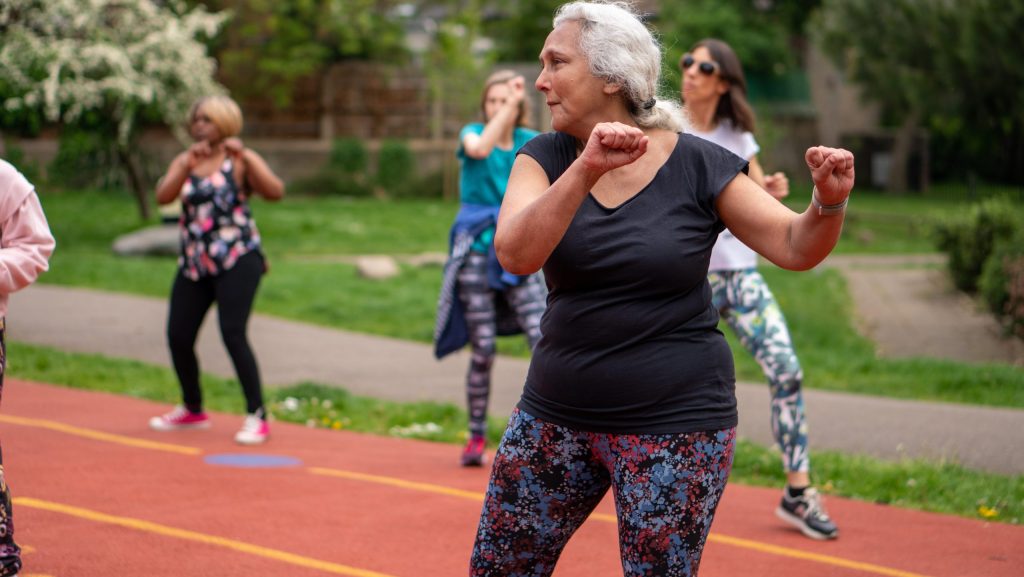Table of Contents
Embracing a healthy and active lifestyle is essential at any age, with its importance magnified for seniors. This focus on health becomes critical as we age, considering the physiological and cognitive changes that occur. Gym workout plans tailored for seniors are fundamental in addressing these changes, offering substantial benefits in physical health, mental well-being, and overall life quality. This guide provides a comprehensive look into senior fitness, emphasizing the impact and benefits of elderly workout routines and age-appropriate exercises.
Did you know that regular physical activity can reduce the risk of chronic diseases and improve cognitive function in seniors? Discover how tailored gym workouts can make a significant difference.
The guide is organized to cover various topics essential for seniors and their caregivers, aimed at providing knowledge and tools for effective fitness practices. The main topics include:
- Benefits of Exercise for Seniors: Detailing how regular physical activity impacts the body and mind positively.
- Safe Gym Workouts for the Elderly: Focusing on low-impact, injury-preventive exercises suitable for senior fitness levels.
- Customizing Workout Plans for Seniors: Discussing the tailoring of exercise regimens to individual needs, considering various health conditions and abilities.
- Nutrition and Recovery for Senior Fitness: Emphasizing the importance of balanced diet and proper recovery methods in workout effectiveness.
- Engaging Seniors in Regular Gym Visits: Outlining strategies to motivate and support seniors in maintaining a consistent exercise routine.
This guide aims to provide seniors with an in-depth understanding of how to optimize their fitness routine. It addresses the unique fitness needs of seniors, ensuring that exercises are safe, effective, and enjoyable. Practical advice is given on overcoming common misconceptions and barriers to exercise, along with strategies for building a supportive fitness community and the benefits of integrating regular gym visits into seniors’ routines.
This comprehensive resource is dedicated to enhancing senior fitness. Whether for seniors starting their fitness journey, caregivers seeking ways to encourage physical activity, or anyone interested in promoting healthy aging, this guide serves as an all-encompassing reference for senior fitness. It’s an invitation to improve health and well-being through informed and tailored fitness plans, regardless of age.
Maintaining a Healthy Lifestyle for Seniors: The Importance of Exercise
Maintaining an active lifestyle through exercise is essential for seniors, offering significant benefits for physical health, mental well-being, and independence. In this section, we focus on the positive impacts of regular physical activity for the elderly, emphasizing its role in healthy aging.
Physical Health Benefits
Exercise plays a crucial role in promoting senior physical health. It is instrumental in managing and preventing chronic diseases prevalent among the elderly, such as heart disease, diabetes, and osteoporosis. Activities that improve muscle strength are particularly beneficial, enhancing muscle mass and bone density, which often decline with age. A combination of aerobic, strength, flexibility, and balance training can significantly boost physical health in seniors, reducing the risk of falls and fractures and improving daily functionality.
| Exercise Type | Benefits for Seniors |
|---|---|
| Aerobic | Enhances cardiovascular health, improves endurance |
| Strength Training | Increases muscle mass, improves bone density |
| Flexibility | Enhances mobility, reduces risk of injuries |
| Balance | Prevents falls, improves coordination |
Mental Health Improvements
Engaging in regular physical activity has a marked positive impact on senior mental well-being. Exercise is known to elevate mood, decrease the likelihood of depression, and alleviate anxiety. A notable aspect is its effect on cognitive functions.
“Studies have shown that regular exercise can improve cognitive function in seniors by up to 20%.”
Activities that require coordination and mental challenge, like dance or tai chi, are particularly effective in enhancing cognitive abilities in seniors. The social aspects of group exercises or gym classes also play a vital role in combating loneliness and isolation, further boosting mental health.
Longevity and Independence
Regular exercise significantly contributes to longevity and maintaining independence in seniors. Active aging, fostered by consistent physical activity, is associated with a longer lifespan and an improved quality of life in later years. Such activities not only extend the years a senior lives but also enrich the quality of these years. By sustaining physical and mental fitness, seniors are more likely to enjoy an independent lifestyle, capable of managing daily tasks and actively participating in community and family activities.

Essential Safe Gym Workouts for the Elderly
Safe gym workouts are essential for seniors to maintain health and prevent injury. This section covers the best practices for elderly fitness, emphasizing low-impact exercises, balance and stability workouts, and injury prevention techniques.
Low-Impact Exercises
Low-impact exercises are crucial for seniors, providing cardiovascular benefits while being gentle on the joints. Activities such as walking, swimming, and cycling are exemplary for this demographic. They improve endurance and flexibility without the high risk of injury associated with more strenuous exercises. Gentle exercises for seniors and joint-friendly workouts are especially important for those with age-related conditions like arthritis, helping to maintain physical activity levels without exacerbating pain or discomfort.
Balance and Stability Workouts
Improving balance and stability is critical for seniors to prevent falls, which are a leading cause of injury in this age group. Workouts that focus on these aspects, such as tai chi, yoga, and leg strength exercises, are highly beneficial.
“Practicing balance exercises regularly can reduce the risk of falls in seniors by up to 40%.”
These exercises enhance proprioception and strengthen muscles that stabilize the body, increasing confidence in daily activities and promoting an independent lifestyle.
Injury Prevention Techniques
Injury prevention is a key component of senior workouts. Safe exercise practices include thorough warm-ups and cool-downs, correct exercise techniques, and the use of suitable equipment. It’s crucial for seniors and their caregivers to be knowledgeable about elderly injury prevention.
- Proper warm-up exercises: Includes light stretching, walking, joint rotations.
- Safe exercise techniques: Emphasizes correct posture and controlled movements.
- Use of appropriate equipment: Involves non-slip mats, comfortable footwear, and supportive gear.
Seniors should also be attentive to their body’s signals and modify exercise intensity and duration as needed. By following these injury prevention methods, seniors can safely engage in physical activities, reaping the benefits while minimizing risk.
Customizing Workout Plans for Seniors
Customizing workout plans for seniors is a critical step in ensuring effective and safe fitness routines. This process involves tailoring exercises to meet individual health conditions, fitness levels, and goals, and is essential for maximizing the benefits of physical activity in later life.
Personalized Exercise Regimens
Individualized exercise regimens are the foundation of effective senior fitness. It’s important to design a workout plan that is tailored to each senior’s physical capabilities and limitations. This typically involves an initial fitness assessment, possibly in consultation with healthcare providers, to determine the appropriate level of exercise. The exercise regimen should aim to meet specific fitness goals, such as improving strength, flexibility, or cardiovascular health, while being mindful of any physical constraints.
| Fitness Goal | Exercise Type |
|---|---|
| Improve Strength | Resistance training, light weightlifting |
| Enhance Flexibility | Yoga, stretching routines |
| Boost Cardiovascular Health | Brisk walking, stationary cycling |
Adjusting Workouts for Health Conditions
Adapting exercise routines to various health conditions is vital in senior fitness. Workouts must be customized to cater to specific health issues such as arthritis, osteoporosis, or heart disease.
“Seniors who engage in tailored exercise routines can experience up to a 30% improvement in specific health condition symptoms.”
Modifying the intensity, duration, or type of exercise is crucial for safety and effectiveness. For example, low-impact aquatic exercises are beneficial for seniors with arthritis, while those with heart conditions might require carefully monitored aerobic routines.
Monitoring Progress and Adaptations
Monitoring progress and adapting workouts accordingly is an essential part of customizing fitness plans for seniors. Regular assessment of the senior’s fitness level is necessary to ensure the exercise regimen remains effective and safe. This includes adjusting the intensity and duration of exercises as the senior’s fitness improves or as health conditions change. Such continuous monitoring and adaptation of workout plans ensure that they remain suitable for the senior’s evolving fitness needs.

Nutrition and Recovery for Senior Fitness
Proper nutrition and recovery are integral components of senior fitness, playing a significant role in health maintenance and exercise effectiveness. This section highlights the importance of dietary habits and recovery processes in the fitness regimen of seniors.
Senior-Specific Nutritional Guidelines
Nutrition is a crucial aspect of senior health and fitness. A balanced diet, rich in essential nutrients, is necessary to support physical activity and overall health. Seniors should focus on a diet that includes:
- Lean Proteins: Essential for muscle repair and maintenance.
- Whole Grains: Provide sustained energy and digestive health.
- Fruits and Vegetables: Rich in vitamins, minerals, and antioxidants.
- Healthy Fats: Important for joint health and overall well-being.
Recovery and Muscle Care
Effective recovery is as important as the exercise itself, particularly for seniors. Recovery strategies should include adequate rest, proper nutrition, and muscle care. Techniques for senior muscle recovery include gentle stretching, relaxation exercises, and possibly heat or cold therapy to alleviate muscle soreness. Nutrition plays a critical role in post-workout recovery; foods rich in protein and carbohydrates are important for muscle repair and energy replenishment.
Hydration and Health
Hydration is essential for senior fitness, with dehydration having a significant impact on physical performance.
“Dehydration can reduce physical performance in seniors by up to 20%, making hydration a key factor in senior fitness.”
Older adults are more prone to dehydration, making it crucial to consume adequate fluids regularly. Water is the best choice for hydration, but other beverages and foods with high water content also contribute to overall hydration needs.

Strategies for Engaging Seniors in Regular Gym Visits
Regular gym visits are essential for senior health and fitness, but maintaining engagement and motivation can be a significant challenge. This section explores effective strategies for encouraging elderly individuals to consistently participate in gym activities, focusing on motivational techniques, community support, and overcoming common barriers.
Motivation and Encouragement Techniques
Motivation plays a crucial role in sustaining a regular exercise regimen among seniors. Implementing effective motivational strategies can significantly increase their participation in gym activities. Key methods include:
- Setting achievable fitness goals
- Celebrating fitness milestones
- Offering varied and enjoyable workout options
These approaches help seniors feel a sense of accomplishment and keep their exercise routine interesting and engaging. Personalized fitness plans that cater to individual interests and abilities can also motivate seniors to maintain regular gym visits.
Building a Supportive Community
Creating a supportive community is instrumental in promoting regular gym attendance among seniors. Participating in a senior fitness community provides essential social support and encouragement. Initiatives can include:
- Group classes specifically for seniors
- Fitness clubs and social events focused on senior health
- Peer support systems within the gym setting
These community-building efforts create a welcoming and motivating environment for seniors, making gym visits more enjoyable and less intimidating.
Overcoming Barriers to Regular Exercise
Many seniors face barriers to regular exercise, such as physical limitations, health concerns, and transportation challenges. Addressing these issues is key to increasing gym participation. Strategies include:
- Providing accessible gym facilities and equipment
- Offering modified exercise programs for various health conditions
- Arranging transportation for seniors to and from the gym
“Studies show that accessible fitness programs can increase senior gym attendance by up to 50%.”
Educational initiatives about the benefits of regular exercise and offering trial sessions can also help seniors overcome fears and misconceptions about gym activities.
Conclusion: Gym Lifestyle: Senior Fitness Plans
This article has covered various aspects of gym workouts tailored for seniors, emphasizing the importance of a comprehensive approach to health and fitness in later years.
“Implement the strategies discussed, from tailored exercises to nutritional care, and embrace a fitness routine that enhances your well-being at every step.”
Key Insights from the Article
- The benefits of regular physical activity for seniors include improved physical and mental health, and enhanced longevity.
- Safe, low-impact exercises and stability workouts are important for injury prevention.
- Customizing workout plans based on individual health conditions and fitness levels is crucial.
- Balanced nutrition and effective recovery strategies play a vital role in senior fitness.
- Motivational strategies and overcoming barriers are key to regular gym visits for seniors.
In conclusion, integrating workouts, nutrition, progress tracking, and healthy habits is crucial for senior fitness. This comprehensive guide provides practical strategies for seniors, caregivers, and fitness professionals, supporting a healthier and more fulfilling lifestyle. The benefits of a well-rounded fitness regimen are extensive, contributing significantly to the quality of life in senior years.